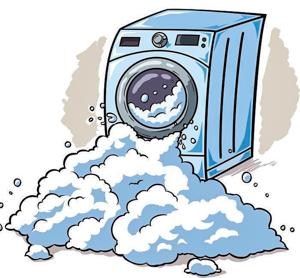I GUESS I SHOWED HER…

During the late summer of 2016 I learned that even though I own half of everything we own, there are limits to when I can use one appliance.
I had spent most of the summer working on a 1987 Chevrolet pickup truck to get it ready for the road. It needed a muffler, tires, brake work, and dozens of other small items. The biggest need was a transmission, as the one in it had no 3rd or 4th gear. I removed one from another old truck and foolishly decided to change the transmissions all by myself.
I did accomplish the switch of transmissions and four-wheel drive transfer unit, but it was a solid week of creeper rides under that truck. Three times the transmission and the transfer unit fell off the jack, spilling quarts of red transmission fluid each time. The first time was a Saturday afternoon – what a mess! I yelled for Peggy to run to the dollar store to buy every bag of kitty litter they had; she returned with a dozen. Kitty litter is the same as oil dry (baked clay) with deodorant and a pretty blue and yellow bag to justify the extra cost. It worked just fine and made the garage smell really nice. But it left a gritty, dusty red film on the garage floor that quickly transferred to my blue coveralls.
The creeper is a tricky tool that I have given many unflattering, derogatory, slang names. It dumped me a dozen times. After many days of riding the creeper and slithering on my back like an inverted lizard while dragging jacks and blocks of wood, I finally filled all of the bolt holes. I waited two days to change the transmission filter and add the new fluid to allow my exhaustion to subside. I had decided if, after this near-death ordeal, the replacement transmission did not work, I would calmly walk out to Route 84 and jump in front of a really big truck. It did work, and I have put about a thousand miles on it so far, easy to spot as it has fresh Caterpillar yellow paint, big new tires and the name RUFUS on the sunshade.
Since I have two pair of blue coveralls, I used both pair and both were soaked with red fluid, dirt, and kitty litter. What a big stinking mess I had made. I used two gallons of degreaser and scrubbed the garage floor four times. My tools were nasty, and the creeper had broken when the transmission fell on it. I replaced the old wooden creeper with a new fiberglass unit with easy to roll wheels and a cushion head rest.
I balled up my filthy, nasty blue coveralls and got as far as the deck when Peggy, with her best drill sergeant voice, yelled, “Halt right there”! She stomped her foot and said, “Oh no you don’t; that mess is NOT going into my washing machine!” My logic that it was half mine did not get me into the house. I made a hasty retreat to the scene of the crime. I put the nasty coveralls aside for a few weeks until I might have an opportunity to sneak them into the house. Then one day Peggy announced that she needed to run to town for a few errands. I guess I smiled too much. She backed her Jeep out of the garage and opened the window and in her dark deep voice said, “If you put those nasty coveralls into my washing machine, call and make yourself an appointment at the Obaugh Funeral Home!”
Then one day the light came on! The laundromat in West Virginia has heavy duty washing machines designed for nasty coveralls. I stuffed them into the washing machine, dumped in too much liquid detergent, and dropped in nine quarters. The water turned black, and the machine looked like a mad dog foaming at the mouth! Suds began to come out the top and around the door gasket and even the floor drain! One of the women there had a whole bunch to say about men in the laundromat making a big mess. She was bigger than me, so I cowered in the corner. After she left I put in nine more quarters (I was out of soap), but there must have been some in the coveralls because this load had suds too.
I did some research and learned that the first laundromat /washeteria was in Fort Worth, Texas in 1934. Another one appeared in Philadelphia, Pennsylvania in 1949. Both places had attendants because the coin operation device had not been invented. That changed in 1957 when Harry Greenwald of New York began selling the coin operation device that enabled customer operation. The Census Bureau reports that from the thousands of laundromats in America, 39,000 people are employed and $3.4 billion dollars is generated annually.
Now I must patiently wait for that day in the future when Peggy tries to jump on my zero-turn mower and cut grass. If I can’t use her washer, she can’t use my mower or creeper!